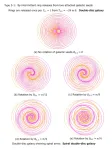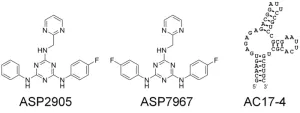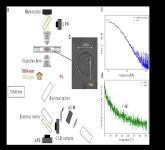(Press-News.org) A novel drug is showing promise for alleviating heart failure, a common condition associated with sleep apnoea and a reduced lifespan.
The drug, known as AF-130, was tested in an animal model at Waipapa Taumata Rau, the University of Auckland where researchers found it improved the heart’s ability to pump, but, equally important, prevented sleep apnoea, which itself reduces lifespan (see Nature Communications). “This drug does offer benefit for heart failure, but it’s two for the price of one, in that it’s also relieving the apnoea for which there is currently no drug, only CPAP (a breathing device), which is poorly tolerated,” says Professor Julian Paton, director of the University’s Manaaki Manawa, Centre for Heart Research.
When a person has a heart attack and subsequent heart failure, the brain responds by activating the sympathetic system, the ‘fight or flight’ response, as a way to stimulate the heart to pump blood. However, the brain persists with this activation of the nervous system, even when it is no longer required, and this together with the consequent sleep apnoea, contributes to the patient’s reduced life expectancy. Most patients die within five years of a heart failure diagnosis.
“This study has revealed the first drug to temper the nervous activity from the brain to the heart thereby reversing the heart’s progressive decline in heart failure,” says Professor Paton.
The part of the brain that sends nervous impulses to the heart is also controlling respiration, so this drug has a dual function, reducing the ‘fight or flight’ response while also stimulating breathing to stop the sleep apnoea. “These findings have real potential for improving the wellness and life expectancy of almost 200,000 people living with heart disease in Aotearoa New Zealand,” says Professor Paton.
Another exciting factor for the scientists, who are from the University of Auckland and the University of São Paulo, Brazil, is that the drug is soon to be FDA approved, albeit for a different health issue, paving the way for human trials in the next year or two, Professor Paton says.
“Over recent decades there have been several classes of drugs that have improved the prognosis of heart failure,” says cardiology consultant and Associate Professor, Martin Stiles. "However, none of these drugs work in the way that this new agent does. So it is exciting to see a novel method that potentially reverses some features of heart failure."
END
Novel drug offers hope for heart failure patients
A novel drug is showing promise for alleviating both heart failure and the sleep apnoea associated with it.
2023-03-30
ELSE PRESS RELEASES FROM THIS DATE:
Symbiotic yeast helps longicorn beetles eat wood
2023-03-30
Even for insects, wood is a tough food source as it contains hard substances such as cellulose. To help make wood more palatable, some wood-feeding insects are assisted by symbiotic microorganisms that break down the components of wood into an edible form. A group from Nagoya University in Japan has isolated a symbiotic yeast from adults, larvae, and eggs of the Japanese longicorn beetle and identified specialized organs that store the yeast, allowing the beetles to break down the unpalatable components of wood. Their findings were published in PLOS ONE.
“I have been fascinated with longicorn beetles ...
Environment: Honeybees provide a snapshot of city landscape and health
2023-03-30
Urban honeybees could be used to gain insight into the microbiome of the cities in which they forage, which can potentially provide information on both hive and human health, reports a study published in Environmental Microbiome.
Cities are built for human habitation but are also spaces that host a wide range of living species, and understanding this diverse landscape is important for urban planning and human health. However, sampling the microbial landscape in a manner to cover wide areas of a city can be labour-intensive.
Elizabeth ...
First successful simulations of how various shapes of galaxies are formed
2023-03-30
The standard cosmology can answer almost nothing about how the structure of a galaxy is formed. It expects a supermassive black hole at the center and dark matter in the halo to explain the circulation of stars and its velocity. However, why the visible matters are distributed in such a thin plane by the interaction with the black hole while dark matter results in a spherical distribution is a critical open question for a disc galaxy. The formation process of elliptical, ring, and long–barred galaxies also remains unknown.
The Energy Circulation ...
Can a solid be a superfluid? Engineering a novel supersolid state from layered 2D materials
2023-03-30
A collaboration of Australian and European physicists predict that layered electronic 2D semiconductors can host a curious quantum phase of matter called the supersolid.
The supersolid is a very counterintuitive phase indeed. It is made up of particles that simultaneously form a rigid crystal and yet at the same time flow without friction since all the particles belong to the same single quantum state.
A solid becomes ‘super’ when its quantum properties match the well-known quantum properties of superconductors. A supersolid simultaneously has two orders, solid and super:
solid because of the spatially repeating pattern ...
ASU associate professor wins Fulbright Award to study sexual-assault prevention
2023-03-30
Throughout her career, Arizona State University Edson College of Nursing and Health Innovation Associate Professor Kelly Davis has worked to translate her research into action. An expert in alcohol-involved sexual assault, Davis’ studies have been cited in U.S. legislation and have earned her a MERIT Award and now the prestigious Fulbright Scholar Award.
The program will take her to the United Kingdom beginning in early 2024 to collaborate with colleagues at the University ...
New RNA-based toolkit to regulate gene activity could advance regenerative medicine, gene therapy and biotechnology
2023-03-30
The Okinawa Institute of Science and Technology (OIST), in collaboration with Astellas Pharma Inc., has developed a new toolkit that uses small molecules to control the activity of a piece of synthetic RNA, and ultimately regulate gene expression. The technology, which was described in the Journal of the American Chemical Society on March 30, 2023, worked in mammalian cell cultures and in mice.
The ability to precisely control whether a gene is turned on or off is expected to lead to more efficient production of compounds that are made using animal cells, and make gene therapy, cell therapy, and regenerative medicine safer.
For genes to be expressed, cells make many RNA copies of a section ...
Babies’ gut microbiome not influenced by mothers’ vaginal microbiome composition
2023-03-30
It has been a longstanding assumption that birth mode and associated exposure of newborns to their mothers’ vaginal microbiome during delivery greatly affects the development of babies’ gut microbiome.
To test the scientific validity of this assumption, a team of Canadian researchers has now published a study in Frontiers in Cellular and Infection Microbiology in which they examined the effect of maternal vaginal microbiome composition on the development of infants’ stool microbiome at 10 days and three months after birth.
“We show that ...
2023 Canada Gairdner Awards recognize world-renowned scientists for transformative contributions to research impacting human health
2023-03-30
The Gairdner Foundation is pleased to announce the 2023 Canada Gairdner Award laureates, recognizing some of the world’s most significant biomedical and global health research and discoveries.
“Congratulations to all the 2023 Canada Gairdner Award recipients! The ground-breaking work of this year’s laureates has resulted in innovative, globally accessible tools to fight diseases and improve our well-being. The work of two Canadian researchers – Dr. Christopher Mushquash and Dr. Gelareh Zadeh especially ...
Researchers use tiny diamonds to create intracellular sensors
2023-03-30
Researchers use tiny diamonds to create intracellular sensors
Optically trapped nanodiamonds could be used to measure temperature, magnetic fields and other properties inside living cells
VANCOUVER -- Researchers have developed a new way to study the intricate dynamics within living cells by using optically trapped nanodiamond particles as intracellular sensors. Using custom built optical tweezers, the research team trapped the particles within the cell at low power while the cell was alive. The work represents an important advancement in quantum sensing, which takes advantage of quantum mechanics to analyze changes at the atomic level.
The researchers used optical tweezers ...
New study identifies key risk factors for surgical site infection following commonly performed surgery
2023-03-30
Arlington, Va., March 30, 2023 – Findings from an analysis of more than 66,000 abdominal hysterectomies performed in New York hospitals reveal key risk factors for surgical site infections (SSIs) following these procedures, including open surgery, obesity, diabetes, gynecological cancer, and age under 45. Published today in the American Journal of Infection Control (AJIC), the data can help inform surgical and clinical decisions to reduce post-operative infections.
“Improved understanding of patient-related, clinical, and surgical factors ...
LAST 30 PRESS RELEASES:
Boosting the cell’s own cleanup
Movement matters: Light activity led to better survival in diabetes, heart, kidney disease
Method developed to identify best treatment combinations for glioblastoma based on unique cellular targets
Self-guided behavioral app helps children with epilepsy sleep earlier
Higher consumption of food preservatives is associated with an increased risk of type 2 diabetes
NTU Singapore-led team captures first-ever ‘twitch’ of the eye’s night-vision cells as they detect light, paving the way for earlier detection of blindness-causing diseases
Global aviation emissions could be halved through maximising efficiency gains, new study shows
Fewer layovers, better-connected airports, more firm growth
Exposure to natural light improves metabolic health
As we age, immune cells protect the spinal cord
New expert guidance urges caution before surgery for patients with treatment-resistant constipation
Solar hydrogen can now be produced efficiently without the scarce metal platinum
Sleeping in on weekends may help boost teens’ mental health
Study: Teens use cellphones for an hour a day at school
After more than two years of war, Palestinian children are hungry, denied education and “like the living dead”
The untold story of life with Prader-Willi syndrome - according to the siblings who live it
How the parasite that ‘gave up sex’ found more hosts – and why its victory won’t last
When is it time to jump? The boiling frog problem of AI use in physics education
Twitter data reveals partisan divide in understanding why pollen season's getting worse
AI is quick but risky for updating old software
Revolutionizing biosecurity: new multi-omics framework to transform invasive species management
From ancient herb to modern medicine: new review unveils the multi-targeted healing potential of Borago officinalis
Building a global scientific community: Biological Diversity Journal announces dual recruitment of Editorial Board and Youth Editorial Board members
Microbes that break down antibiotics help protect ecosystems under drug pollution
Smart biochar that remembers pollutants offers a new way to clean water and recycle biomass
Rice genes matter more than domestication in shaping plant microbiomes
Ticking time bomb: Some farmers report as many as 70 tick encounters over a 6-month period
Turning garden and crop waste into plastics
Scientists discover ‘platypus galaxies’ in the early universe
Seeing thyroid cancer in a new light: when AI meets label-free imaging in the operating room
[Press-News.org] Novel drug offers hope for heart failure patientsA novel drug is showing promise for alleviating both heart failure and the sleep apnoea associated with it.





